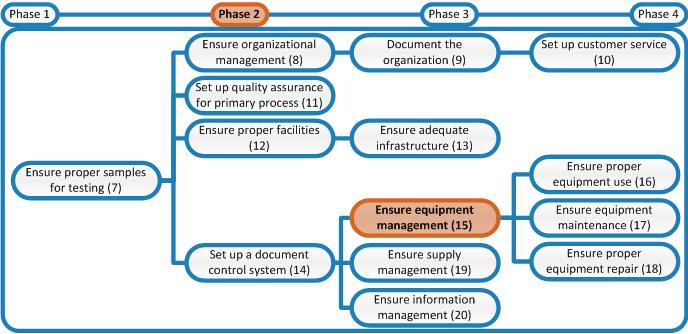
Title
Why
For several types of equipment the maintenance needs are depended on the hours of use. In addition, it is convenient to have an overview of when what maintenance was performed on each piece of equipment. Based on this overview new service appointments can be planned. It also provides an indication of the costs involved in using each piece of equipment. Therefore, maintenance and Usage Log Sheets need to be introduced on which this can be recorded. Based on that the Equipment Officer can decide when the next maintenance is needed.
What
Establish for each piece of equipment a Maintenance Log Sheet and, where applicable, a Usage Log Sheet. The Maintenance Log Sheet is used to record maintenance in one overview for each piece of equipment. The Usage Log Sheet only has to be made for equipment where this is needed. E.g. for a flow cabinet and for centrifuges it must be recorded for how many hours they have been used. This allows you to determine when maintenance is needed based on hours of use.
NOTE: Some laboratories distinguish between the terms "Servicing" and "Maintenance", with "servicing" being the maintenance performed by an external maintenance company, and "maintenance" being the maintenance performed by the laboratory itself. In this tool we only use the term "Maintenance" which also includes servicing.
How & who
Equipment Officer:
- Make a Maintenance Log Sheet. A template of such a form is provided in the right-hand column. Note that this is just an example. If another format works better for you, use that format. Make sure that the unique code and name of each piece of equipment is clearly shown on each sheet.
- Take a new folder and name this "Equipment Archive". Insert a tab for each piece of equipment.
- Each time maintenance is done on a piece of equipment a Maintenance Log Sheet needs to be filled-out to record details of the maintenance. Store filled-out Maintenance Log Sheets behind the right tab.
- Determine, based on the Equipment Register and the manuals, which pieces of equipment need to be supplied with a Usage Log Sheet.
- Make for these pieces of equipment a Usage Log Sheet. The format of this sheet depends on the piece of equipment. E.g. for a centrifuge you have to insert other parameters (such as rotations per minute and temperature) than for a flow cabinet (only hours of use). Make sure that the unique code and name of each piece of equipment are clearly shown on each sheet. An example Usage Log Sheet is provided in the right-hand column.
- The templates of the Maintenance sheets and Usage Log Sheets must be stored as appendix to the SOPs that have been written in phase 1 for each piece of equipment. Therefore, each sheet must receive the same code as the SOPs of which they will be part. E.g. if a sheet will be attached to Equipment SOP E04, the code for the sheet will be E04F1 (F1=form 1). This way you can see that the sheet is part of Equipment SOP number 4.
- Place the Usage Log Sheets near the pieces of equipment they have been developed for. If there is a risk that the forms become wet, protect the sheets by putting them in a plastic document pouch or in a binder (easier access). Supply the sheets with a pen. This prevents that sheets are not filled-out because the technologist may not have a pen on him/her at that moment.
- Present the Usage Log Sheets to all staff members during a weekly staff meeting. Explain for each piece of equipment what data has to be recorded on the forms, when this should be done and why this should be done. Explain where to find the Usage Log Sheets.
- Regularly check if Usage Log Sheets are full. If this is the case, print a new log sheet and replace the completed one with the new one. Analyze the full log sheet to see whether maintenance is needed in the near future. If this is the case, make an appointment for maintenance. Store the completed log sheet behind the correct tab in the Equipment Archive folder.


